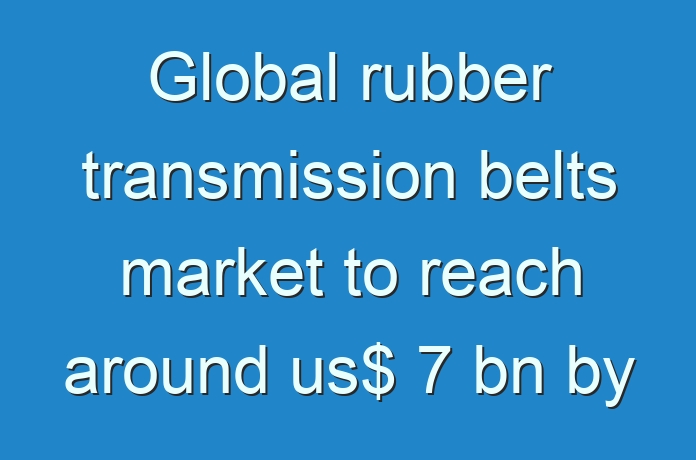
The global rubber transmission belts market was valued at around US$ 5 Bn in 2017 and is projected to expand at a CAGR of 4.16% from 2018 to 2026, according to a new report titled ‘Rubber Transmission Belts Market – Global Industry Analysis, Size, Share, Growth, Trends, and Forecast, 2018–2026,’ published by Transparency Market Research (TMR) .Growth of the automotive sector across the world and increase in the number of manufacturing plants are key factors driving the global rubber transmission belts market. Additionally, availability of raw material in abundance is fueling the market.
In terms of product, the global rubber transmission belts market has been classified into raw edged belts, V-belts, timing belts, wrapped belts, specialty belts, and others. The V-belts segment held a dominant i.e. 37.94% share of the global rubber transmission belts market in 2017. The timing belts segment is expected to expand at a CAGR of 3.94% from 2018 to 2026. The speciality belts segment is expected to expand at a significant growth rate in the near future. Specialty belts are customized belts that are designed to meet specific requirements of customers.
Request a Sample-
https://www.transparencymarketresearch.com/sample/sample.php?flag=S&rep_id=16850
Based on application, the rubber transmission belts market can be segregated into industrial, automotive components, agricultural equipment, mining, and others. Among these, industrial is the dominant segment. In industrial manufacturing units, various machines are operated at an optimum speed, wherein belt drives used need to be of the finest quality so as to sustain in harsh conditions such as transferring heavy loads. Manufacturing and automotive sectors offer a wide consumer base for rubber transmission belts. Rubber transmission belts provide automotive and manufacturing industries with machine systems that can be directly employed for assembling parts.
Rising popularity of electric vehicles is a key factor hampering the rubber transmission belts market. Furthermore, fluctuating rubber prices have been hampering the global rubber transmission belts market over the last few years. Moreover, presence of a large number of unorganized local players offering their products at a competitive price has disrupted the position of prominent players in the rubber transmission belts market in the last few years.
Request for covid19 impact analysis –
https://www.transparencymarketresearch.com/sample/sample.php?flag=covid19&rep_id=16850
Key market players profiled in the research study include ContiTech AG, Gates Industrial Corporation plc, SKF, DRB, Mitsuboshi Belting Ltd., HIC International Co Inc., Hanna Rubber Company, Jonson Rubber Industries Limited, Chiorino S.p.A., Megadyne Group, and Habasit AG.
The global rubber transmission belts market has been segmented as follows:
Global Rubber Transmission Belts Market, by Product
- Raw Edged Belts
- V-belts
- Timing Belts
- Wrapped Belts
- Specialty Belts
- Others (Flat Belts, Grooved Belts, Round Belts, Ribbed Belts, etc.)
Global Rubber Transmission Belts Market, by Application
- Industrial
- Automotive Components
- Agricultural Equipment
- Mining
- Others (Aerospace, Food, Textile, etc.)
Buy now-
https://www.transparencymarketresearch.com/checkout.php?rep_id=16850<ype=S
Global Rubber Transmission Belts Market, by Region
- North America
- S.
- Canada
- Europe
- Germany
- K.
- Italy
- France
- Spain
- Russia & CIS
- Rest of Europe
- Asia Pacific (APAC)
- China
- Japan
- India
- ASEAN
- Rest of Asia Pacific
- Middle East & Africa (MEA)
- GCC
- South Africa
- Rest of Middle East & Africa
- South America
- Brazil
- Mexico
- Rest of South America
Companies in the Rubber Transmission Belt market have increasingly shifted gears with wide application of digital technology across the continuum, from raw material sourcing to manufacturing to generation of final output, to warehousing to final distribution operations. Among the various affects, the market is witnessing new growth economics due to thinning of line between specialty and commodity businesses that are associated with the larger ecosystem. At the same time, new growth parameters are being vigorously being debated as industry stakeholders put greater emphasis on the circular economy processes.
More Trending Report-





